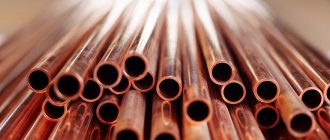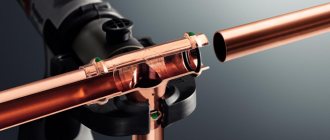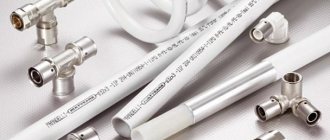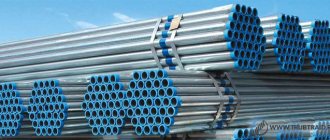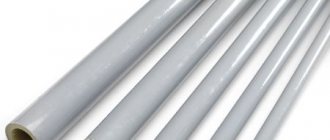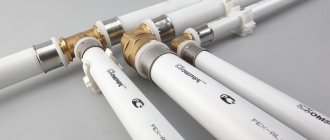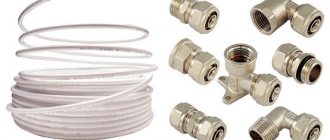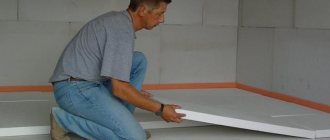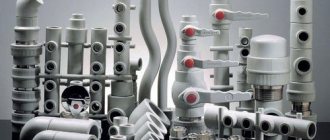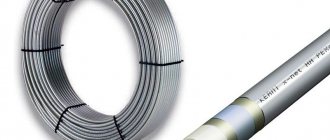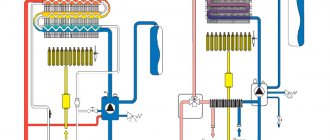Metal-plastic pipes are now very popular. They are used in private houses, apartments, industrial buildings and boiler houses. Such products have gained immense popularity among city residents for a reason, because they have several functions at once:
- metal-plastic pipes are capable of conducting liquid heated to 110 degrees;
- they can be bent manually to the required angle without damaging the structure.
What explains the popularity of MP pipes?
Metal-plastic pipes consist of two materials - polyethylene and aluminum. They have become indispensable in places where it is necessary to transport hot or cold water, gas, and liquids for heating homes.
Thanks to their incredible flexibility, modern pipes are easy to install, minimizing the use of welding and additional equipment (fittings). Thanks to these advantages, it has become possible to use metal-plastic to solve a number of problems:
- installation of heated floors, pipes made of aluminum and plastic are used as heating;
- the pipeline can be hidden inside the walls;
- thanks to modern pipes, it has become incredibly convenient to make connections to heating radiators;
- At the dacha, MP pipes are used for installing irrigation systems.
Production of modern pipes
Metal-plastic pipes consist of a two-layer molecularly cross-linked polypropylene called PE-X. A thin aluminum substrate is laid between it. All three layers are connected using a specially developed adhesive composition. Each manufacturer strives to use its own individual adhesive composition.
Aluminum gives the pipes strength, and thanks to propylene, you can bend such plumbing equipment at an angle without much effort. Aluminum tape of minimal thickness is made of two semicircular fragments. They are connected end-to-end or overlapped with each other. For reliable adhesion, welding is used using ultrasound. After this procedure, layers of polypropylene with an adhesive composition are applied on the outside and inside.
After reliable coupling, the pipes must be marked and coiled for ease of transportation. It is in this form that they arrive in stores.
Design Features
Metal-plastic pipes are made of composite material and have a five-layer wall structure, where the inner and outer layers are polymer, an adhesive mass is used as two connecting layers, and the barrier layer is made of aluminum foil.
Aluminum layer thickness and connection method
The thickness of aluminum foil is usually 0.15-0.6 mm. The best option for arranging heating systems are metal-plastic pipes with a reinforcing layer thickness in the range of 0.3-0.55 mm. They have sufficient flexibility and strength.
In the production of metal-plastic pipes, laser or ultrasonic welding is used to join aluminum.
The joint is performed in one of the following ways:
- Overlapping. In the finished product, a seam is formed at the weld joint, therefore, in order to maintain the evenness of the surface, manufacturers reduce the thickness of the foil, compensating for the thickening.
- Butt. The edges of the aluminum foil fit tightly to each other and are connected without any thickening. The walls of the reinforcing layer are perfectly smooth along the entire length of the pipe.
Type of plastic in the inner and outer layer
To make the outer and inner layers in high-quality metal-plastic pipes for heating, the following types of plastic are used:
. During production, special crosslinking additives are introduced into the raw materials, giving the material improved mechanical characteristics and resistance to pressure and temperature changes.
. It has a unique molecular structure that allows this material to achieve high impact resistance, resistance to cracking during bending, and heat resistance over a wide range of operating temperatures (from -50 ºC to +95 ºC).
Products that use varieties of low-density polyethylene PEHD, PE-RS, PE and HDPE for the same purposes can be operated at temperatures not exceeding +75 ºС. When the parameters are exceeded, the plasticity and fluidity of plastics increases, which can lead to loss of integrity of metal-plastic heating pipes. In addition, products made from low-density polyethylene wear out quickly when exposed to ultraviolet rays, so they need to be insulated.
Bonding layer
Plastic and metal are combined with special compounds, the properties of which make it possible to combine layers of different materials into a single structure. The proportions of components in the composition of each company may vary, but the requirements for glue for safety for human health are strictly observed.
Adhesive layers not only act as a binding material, but are also responsible for the elasticity of metal-plastic heating pipes. When the glue loses its elasticity, the product delaminates and leaks occur. Therefore, when choosing such pipe products for heating, it is necessary to check the cut for the absence of delamination. The presence of delamination is a prerequisite that the heating system wiring assembled from such pipes will quickly fail.
Manufacturing technology of MP pipes
The cross-sectional design of such pipes can be described as follows:
- Outer layer made of polyethylene.
- Glue.
- Non-ferrous metal foil.
- Glue again.
- Inner layer made of polyethylene.
It is thanks to this design that the service life of metal-plastic pipes in an apartment reaches several decades. The white color of the plastic pipes was not chosen by chance, because the coating looks aesthetically pleasing. In addition, there is no need to periodically tint the pipeline.
Two layers of polyethylene (inner and outer) provide a smooth inner surface, thanks to which water can easily flow into the sink. There is no scale left on the walls of the pipeline and no plaque settles. The outer protective layer serves as protection for the aluminum film when joining pipes to each other and to metal parts, preventing galvanic processes. Also, the plastic surface prevents the formation of condensation. Thanks to this important property, the service life of metal-plastic pipes increases significantly.
The design of MP pipes incorporates all the positive qualities of two materials – metal and plastic. Such plumbing products can now be widely used in water supply systems, sewerage systems, air conditioning systems, and more. In addition, plastic is not subject to corrosion, so the service life of metal-plastic pipes significantly exceeds their predecessors, made without the use of polypropylene.
Polyethylene withstands aggressive environments and can withstand heating up to 110 degrees, without emitting harmful, toxic substances. The aluminum foil embedded in modern pipes with a thickness of no more than 400 microns is capable of withstanding high pressure, which is important for the use of pipelines for plumbing purposes. Subject to proper operation, the manufacturer guarantees a service life of metal-plastic heating pipes of about 50 years without repair.
“Warm” floor using metal-plastic pipes
The technical characteristics of metal-plastic pipes made it possible to establish the production of cost-effective additional heating systems for floor coverings in apartments with a sufficient degree of heat transfer.
Installation of heated floors
The absence of pipe deformation under the influence of high coolant temperatures (up to 95º), flexibility, and a smooth inner surface allows for the installation of a reliable heating system.
The service life of heated floors made of metal-plastic pipes is 25 years. According to consumer reviews, a well-installed heating system allows you to create additional comfort in the room.
The reason that reduces the service life of “warm” floors is the use of low-quality coolant (water), which leads to the deposition of insoluble compounds (scale) at the junctions of pipes using fittings.
Scope of application of MP pipes
In addition to water supply, sewerage, and heating, plastic pipes with aluminum foil are used for the following purposes:
- transportation of compressed air over long distances;
- in air conditioning systems;
- for installation of electrical cables as protection against force fields and fire prevention as a result of a short circuit;
- transportation of liquid and gaseous substances.
Despite the fairly long service life of metal-plastic pipes and characteristics that allow them to be used not only in everyday life, but also in industry, they also have a number of limitations in operation:
- In the centralized heating system of residential buildings, if there are elevator units.
- It is prohibited to use in premises of category “G” as fire protection.
- In piping systems where pressure exceeds 10 bar.
- In places where the heating temperature of the pipe may exceed 150 degrees.
Dimensions of plastic and metal pipes
With a fairly long service life, metal-plastic pipes for water supply are produced by both domestic and foreign manufacturers of various diameters (from 16 to 63 mm). Before installation, a pipe is selected, taking into account only the outer diameter.
As a rule, to install a water supply system in a private house or apartment, pipes with an outer diameter of 16 to 26 mm are used. If a large network for transporting water is deployed in the house, then larger diameter pipes are used - 32 and 40 mm. In this case, the main line is constructed from pipes of a much larger diameter, but the connection to individual plumbing fixtures is carried out using pipes of a smaller outer diameter.
Do-it-yourself installation of metal-plastic pipes
You can do the installation of metal-plastic pipes yourself. There is no fundamental difference from installing plastic. Installation of systems made of PE-X or polypropylene does not require expensive tools or equipment.
Required tools and materials
To cut and strip pipes you will need a special pipe cutter or grinder and a round file.
To weld polypropylene you will need a special soldering iron with attachments (see photo):
To install the system using fittings, use two adjustable wrenches and press pliers (manual mechanical press).
Drawings and diagrams
Any work must begin with a drawing or diagram. First, draw the layout of the plumbing system, calculate the amount of all materials and only then buy them. This will help you avoid purchasing unnecessary items and lay out the wiring in the most optimal way.
Installation technology
Before installation, it is necessary to cut the workpieces to the required size and remove burrs.
Compression fittings are connected to the workpiece very simply:
- the unscrewed crimp nut is put on the workpiece;
- the workpiece is inserted into the fitting;
- the nut is tightened by hand; then tightened with wrenches about a turn and a quarter.
Press fittings are installed as follows:
- Put a sleeve on the end of the workpiece, insert the inner liner into the workpiece until it stops;
- Insert the fitting with the workpiece into the press jaws and squeeze the press handle until it stops. Clear imprints from the press clamps will appear on the sleeve.
The technology of diffusion welding of pipes is somewhat more complicated.
Work progress
Before diffusion welding, you should thoroughly wipe the end of the workpiece from dust, dirt, sand, burrs and degrease it with alcohol.
The required nozzle is installed on the welding machine, and the heating temperature is set to 260°C. The soldering iron is heated for about 6-8 minutes, then it itself maintains the desired temperature.
The required fitting and the end of the workpiece are inserted into the nozzles, heated for 6 seconds for a pipe diameter of 20 mm, for a diameter of 25 mm - 7 seconds, for a diameter of 32 mm - 8 seconds.
Very quickly insert the workpiece into the fitting until it stops, pressing for at least 10 seconds. Then the connection is left untouched for 7-8-10 minutes - the plastic is allowed to cool and polymerize.
You can see the progress of work in detail in our video:
Installation features
If, after crimping with press pliers, clear ring marks from the pliers do not form on the sleeve, the connection should be cut and assembled using a new fitting and a new workpiece. A new fitting cannot be installed on a damaged tube tip.
Bending of polyethylene blanks is done using a pipe bender or a Volnov machine. You can bend the workpiece with your hands, but the bending radius is large.
During installation, you need to ensure that there are no burrs on the workpieces - they clog the pipeline.
Every 0.5-0.8 m the pipeline must be secured in special clip holders - this will help maintain its shape.
Checking the water supply
After assembling the entire system, it is necessary to fill it with water from the network, bleed the air and inspect all connections. You can wrap all the connecting nodes in toilet paper - droplets of moisture will be very visible on it.
Advantages of plastic pipes
Hot water has virtually no effect on the service life of metal-plastic pipes. In addition, such structures have a number of other positive qualities:
- Completely environmentally safe when used correctly.
- High resistance to chemical influences.
- Long service life without maintenance or repair.
- The pipe walls always remain clean, preventing plaque from settling on the inner surface.
- High throughput compared to metal predecessors.
- Small mass.
- Flexibility.
- Virtually waste-free use.
- Quite simple installation that does not require knowledge or expensive tools.
- The ability to bury pipes in cement or concrete, disguising them in apartments and houses. This way, not only the aesthetic appearance is preserved, but also space in the room is saved.
- If repairs are necessary, they can be easily restored.
- Decent appearance.
- Low price.
- Sound-absorbing properties.
- Does not accumulate static voltage.
- Low thermal conductivity coefficient.
Metal-plastic pipes for central heating: pros and cons
Currently, metal-plastic pipes are installed not only in apartments, but also in large shopping centers, although experts do not recommend this. After all, if possible, it is better to replace all circuits with steel pipes. But in most cases, the operation of metal-plastic products does not cause problems; the latter can arise only due to some unforeseen factors. For example, with a sharp increase in pressure, such a pipe may simply burst. But let's look at the pros and cons in more detail. Let's start with the advantages:
- ease of installation. Metal-plastic structures can really be assembled with your own hands, and this does not even require any complex tools. But to install steel pipes you will need a welding machine and skills to handle it. Do not forget that steel pipes are not easy to cut or bend;
- even when using reliable press fittings, you only need special pliers, which cost several thousand rubles;
- service life of metal-plastic pipes. The declared service life of such products (with proper use, of course) is 50 years. But the first leaks in steel central heating systems usually appear after ten years of operation;
- Corrosion is not a problem for metal-plastic pipes, and, as a rule, various deposits do not appear in them.
Now let's move on to the disadvantages, of which there are actually only two:
- low tensile strength of pipes, which does not exceed twenty atmospheres;
- quite high cost. Thus, a steel water and gas pipe, which can also be used for gas and water pipelines, costs about half as much.
Negative factors for MP pipes
But such plumbing structures also have a significant drawback - the service life of fittings on metal-plastic pipes is reduced due to sudden temperature changes. Leaks around pipe connections occur because aluminum and plastic have different coefficients of thermal expansion. When suddenly heated, aluminum expands more slowly, and when cooled, the non-ferrous metal returns to its original form much faster. This difference has a negative impact on MP pipes, and leaks often occur.
The service life of metal-plastic water supply pipes does not change if they are bent. However, repeated bending of the material can lead to rupture of the aluminum film inside. The material can be bent to a certain radius, not exceeding eight times the outer diameter of the product.
The long service life of metal-plastic pipes and their popularity is also explained by the fact that they can be bent by hand without much effort. To do this, you need to fill the cavity of the product with sand and bend it to the required state.
The manufacturer warns that bending of plastic plumbing products and twisting relative to their axis is not allowed.
Characteristics of MP pipes
The most popular are pipes with an outer diameter of 16 and 20 mm. Using their example, we will consider the technical characteristics of metal and plastic products.
The pressure in the pipeline system depends on the diameter of the pipe, the thickness of the metal wall, and the water passing through it.
If the water in the pipes is heated to 95 degrees, then the pipe must be designed for a pressure of 10 bar. If the water temperature is 25 degrees, then the structure in the water supply system must withstand 25 bar.
Plastic pipes with the addition of aluminum can withstand high temperatures, reaching up to 110 degrees, however, under one condition - such an increase should be short-term. In this case, the strength of the metal-plastic product will not be compromised. Modern pipes will burst only if the internal pressure reaches 94 bar and the temperature of the liquid inside is about 20 degrees.
Features of application in water supply systems
The water supply network is the most common area of application for metal-plastic pipes. Before choosing a product and installing it, you should remember that the properties of hot and cold water pipes are different. In addition, the same water supply in two different houses may require the selection of metal-plastic pipes with different properties.
An important parameter is the temperature of the internal environment. Any metal-plastic pipes are suitable for cold water supply. The main thing here is to decide on the diameter of the pipe. The more consumers are on the site, the more water is needed, the larger the internal cross-section of the pipe should be. The pressure inside the system also affects the condition of the product. The greater the pressure, the larger the internal diameter should be.
Hot water plumbing requires more care. Here it is important to choose the right type of plastic layer for the pipe. Preference should be given to high-density polyethylene and heat-resistant polyethylene. Before purchasing pipes, you should find out in advance what the temperature of the internal environment in the water supply system is, what pressure there is, volumes of water and temperature fluctuations. These parameters are then compared with those indicated in the markings on the pipes.
Note! It is better to choose those options that imply a reserve of temperature and mechanical stability.
Since a cold water system may supply potable water, the safety of the pipe's interior is important. Polyethylene and polypropylene do not dissolve in water and do not impart taste or odor to it. Bacteria practically do not grow on the smooth surfaces of plastic pipes. Over time, the water does not acquire a rusty taste.
We recommend that you read: Which gutters for water collection should you prefer: metal or plastic?
